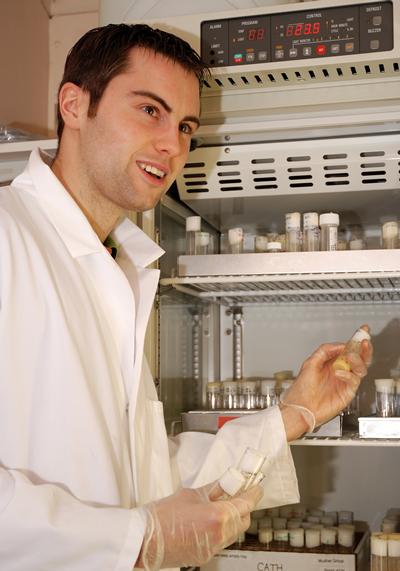Chris Sinadinos PhD: 'The role of heat shock protein chaperones during axonal transport in basal and stress conditions'
Ongoing postgraduate research

Hi, I'm Chris Sinadinos and I studied PhD: 'The role of heat shock protein chaperones during axonal transport in basal and stress conditions' within Centre for Biological Sciences at the University of Southampton.
I enjoy doing demonstration work with undergraduates and I have visited schools talking about my research.
Few people other than scientists realise the essential part fruit flies play in our knowledge of disease. But to postgraduate Chris Sinadinos and other neuroscientists in Biological Sciences, these tiny flies are an integral part of research into neurodegenerative diseases such as Huntingdon’s and Alzheimer’s, as their cell structure is so similar to the human version.
Chris has always been fascinated by the problems of disease ever since one of his teachers at school in Wales shared his enthusiasm about how cells function. After doing Biology, Maths and Chemistry at A level, with English Literature (always useful when writing reports and theses), Chris found himself studying for a Biochemistry degree at Oxford followed by an additional year doing a Masters.
He was particularly interested in classical genetics, mapping mutations and transferring the concept to modelling human conditions, so he then looked around for a University where he could continue his interest in studying disease and decided Southampton would be the best choice. He now has four years of funding for his studies.
Mch of Chris’s work centres around Drosophila, or the common fruit fly, and its larvae. The hardy fruit flies, which can withstand a ten-degree Celsius change in temperature, are treated as cosseted animals, carefully nurtured on a mix of corn flour, yeast, agar, sugar and curcumin, a powdered spice which scientists are using to investigate its benefits in dementia research. The flies are given a light anaesthetic of carbon dioxide while their vials are cleaned out, which lasts a couple of minutes, and they can then be sorted with a small paintbrush and poured into new living quarters.
“Recent research suggests that one of the first processes to go wrong in diseases such as Alzheimer’s is the transport of materials along the cells of our nervous system and brain,” he says. “As the whole lifecycle of the fly is only 12 days, studying the larvae is an ideal way of viewing this process rapidly in a real biological environment. We can learn more about how it happens, the particular molecules involved, and even screen for drugs that could possibly be used eventually in human trials.”
Chris intends to complete his thesis by Summer 2010, and may possibly do a postdoctorate qualification or go into teaching. “I enjoy doing demonstration work with undergraduates,” he says, “and I have visited schools talking about my research. It’s an international community so there are lots of possibilities, including working in the biotech industry in the United States or Europe.”
Whatever happens, the tiny fruit fly and its larvae will have played a huge part in Chris’s understanding of disease. “Who knows?” he says, “perhaps a cure for Huntington’s or Alzheimer’s lies wrapped inside them, waiting to be unearthed by hard work and an appreciation of the many similarities between creatures great and small!”